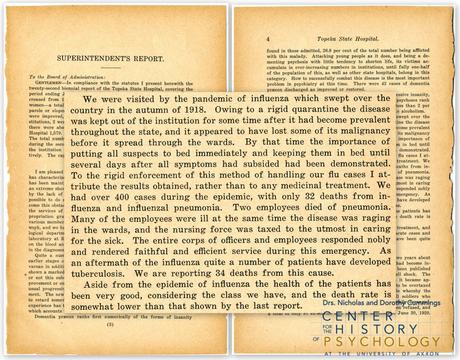- contributed by Lizette Royer Barton.
I’d like to revisit what the CCHP can offer to remote users, especially instructors, during these bizarro times in which we are living. I’m being ambitious and making this a series of blog posts. First up, the asylum reports.
A few months ago I wrote an invited column for The General Psychologist, the newsletter for the Society for General Psychology (APA Division 1) titled, “Primary Sources in the Classroom: Project Ideas for Investigating Mental Health Care in the United States Through Digitized Asylum Reports.”
You can read my Division 1 column for numerous project ideas using our Cushing Memorial Library Collection of Asylum Reports. Remember, our asylum reports are digitized and available as full-text, word-searchable PDFs in our online repository. You can take away some ideas from that column or you can work on creating your own projects. Maybe you’re just bored and want to research asylum reports for the heck of it – do it!
All that being said, I’d like to introduce a specific project and provide some resources and ideas for how you can make it work with your students.
Asylums and epidemic diseases
We are living through a global pandemic right now but disease and illness in the enclosed, often overcrowded spaces of asylums was common. I did word searches for keywords like pandemic, epidemic, influenza, small pox, cholera, and a few others. I went through my hits and decided to focus on two specific asylums – Topeka State Hospital in Kansas (1915, 1919, 1923) and the Government Hospital for the Insane, also known as St. Elizabeth’s, in Washington, DC (1914, 1921, 1926). I took the date of the reports in my searching into account and selected reports before and after the 1918 Influenza Pandemic.

You can access the reports through the links above. You can also access the reports in a shared OneDrive folder here. Download the PDFs from either location and get to work!
Reports typically provide statistics, including physical illness and death, about the patients in their care so that is a great place to start.
Identify epidemic diseases (influenza, small pox, typhoid, etc.) in the reports. Look for how many patients contracted one of those diseases and how many died from it. Compare the data from one report to the next. What changed during the years in between? Did the population of patients increase or decrease? Did the illnesses within the asylum mirror what was happening outside of the asylum? Did vaccinations increase? Were they vaccinating? Did vaccinations for the disease in question even exist?
If a report specifically mentions the 1918 Influenza Pandemic – what does it say? How widespread was influenza within the asylum? How did it compare to the illness outside the asylum? What steps were taken to mitigate the spread of disease? Were staff affected?
Both Topeka State Hospital and St. Elizabeth’s were designed according to the Kirkbride Plan – an architectural design that included numerous wings for patients and patient activities. This design may have provided less opportunity for distancing as compared to another asylum style known as the Cottage Plan. Have your students do a bit of research on these two design styles in order to determine the pros and cons of each during an epidemic.
If you are digging any of these ideas and would like to work together to create something a bit more concrete for use in your class please reach out to me directly – [email protected]. I’m happy to help.
